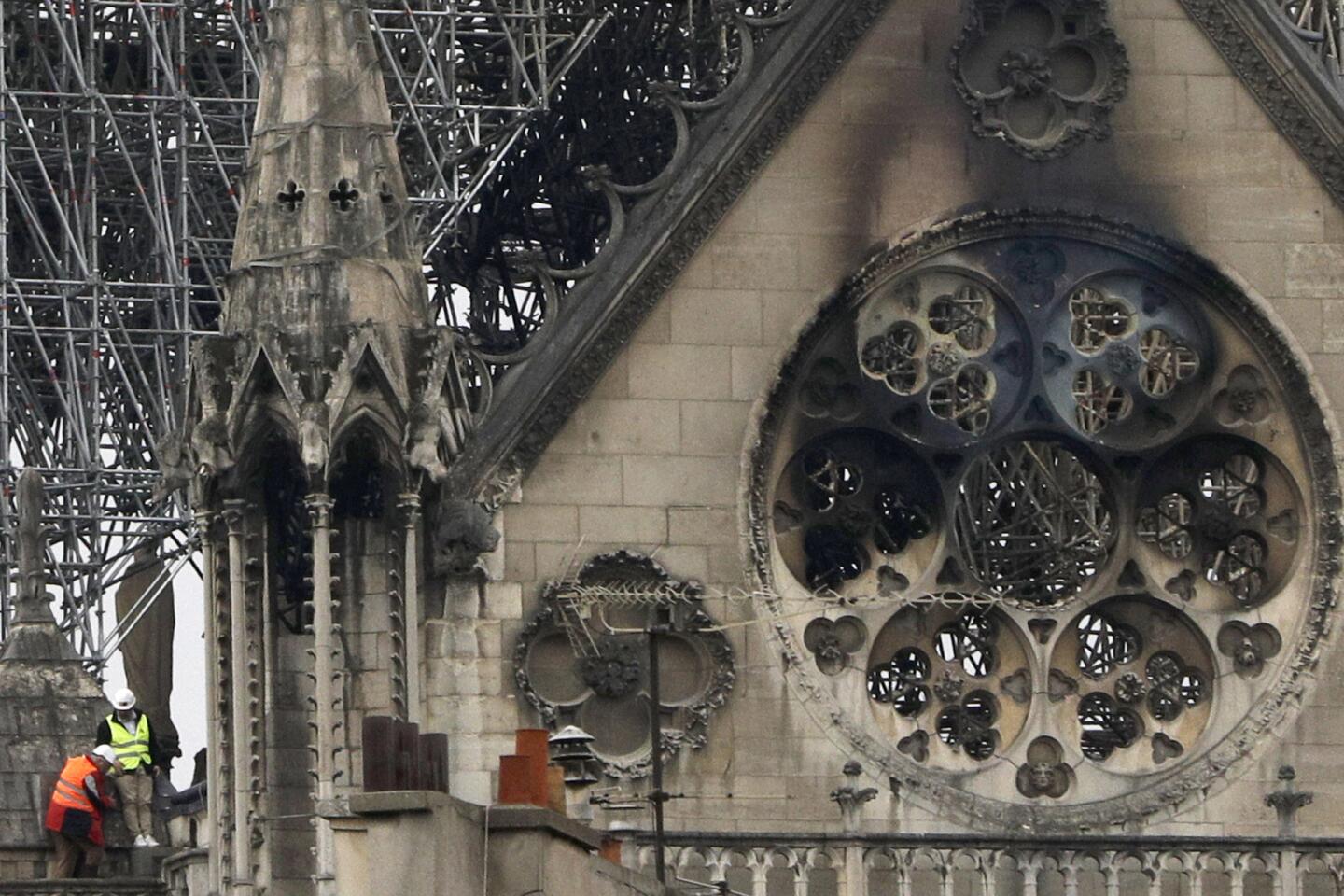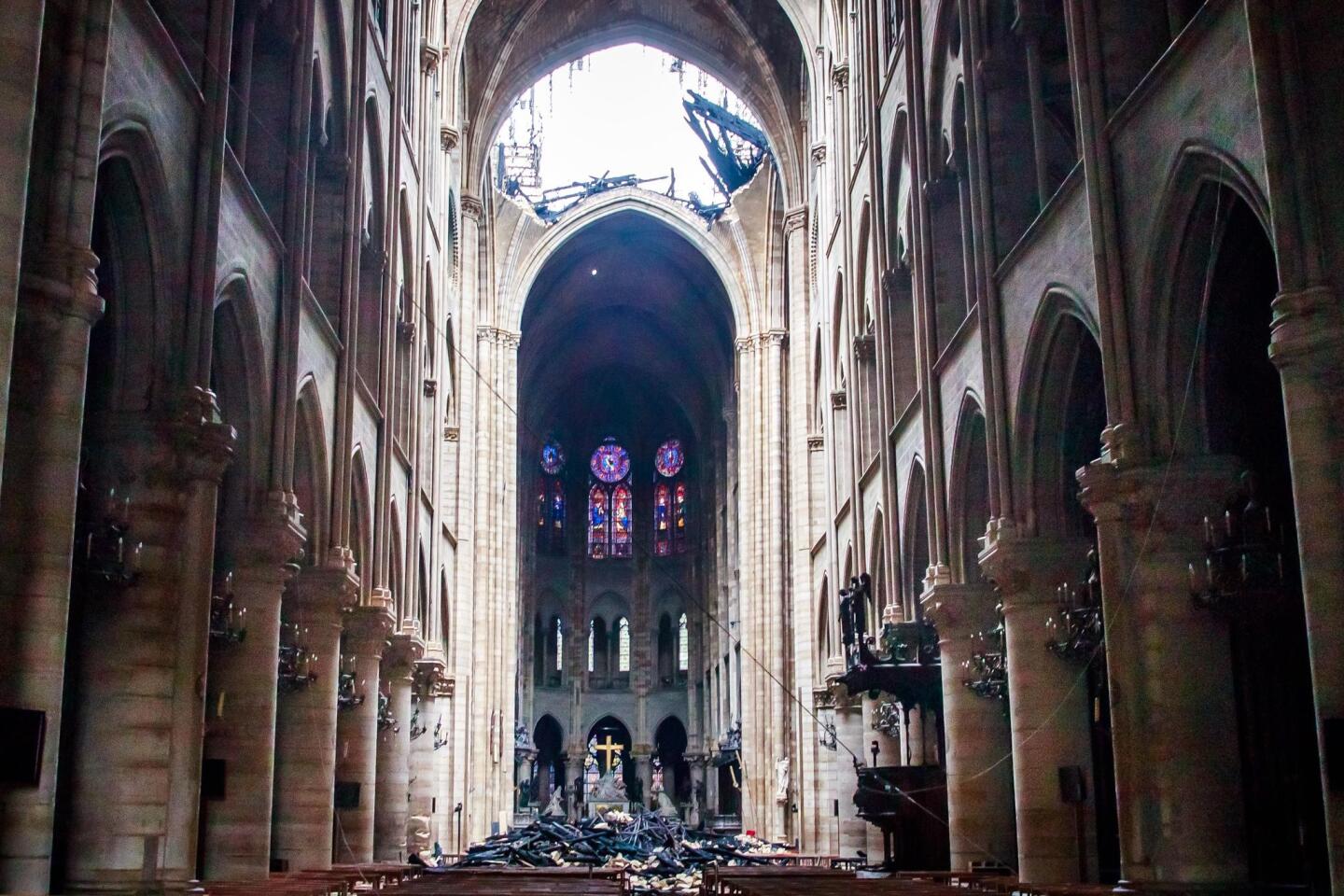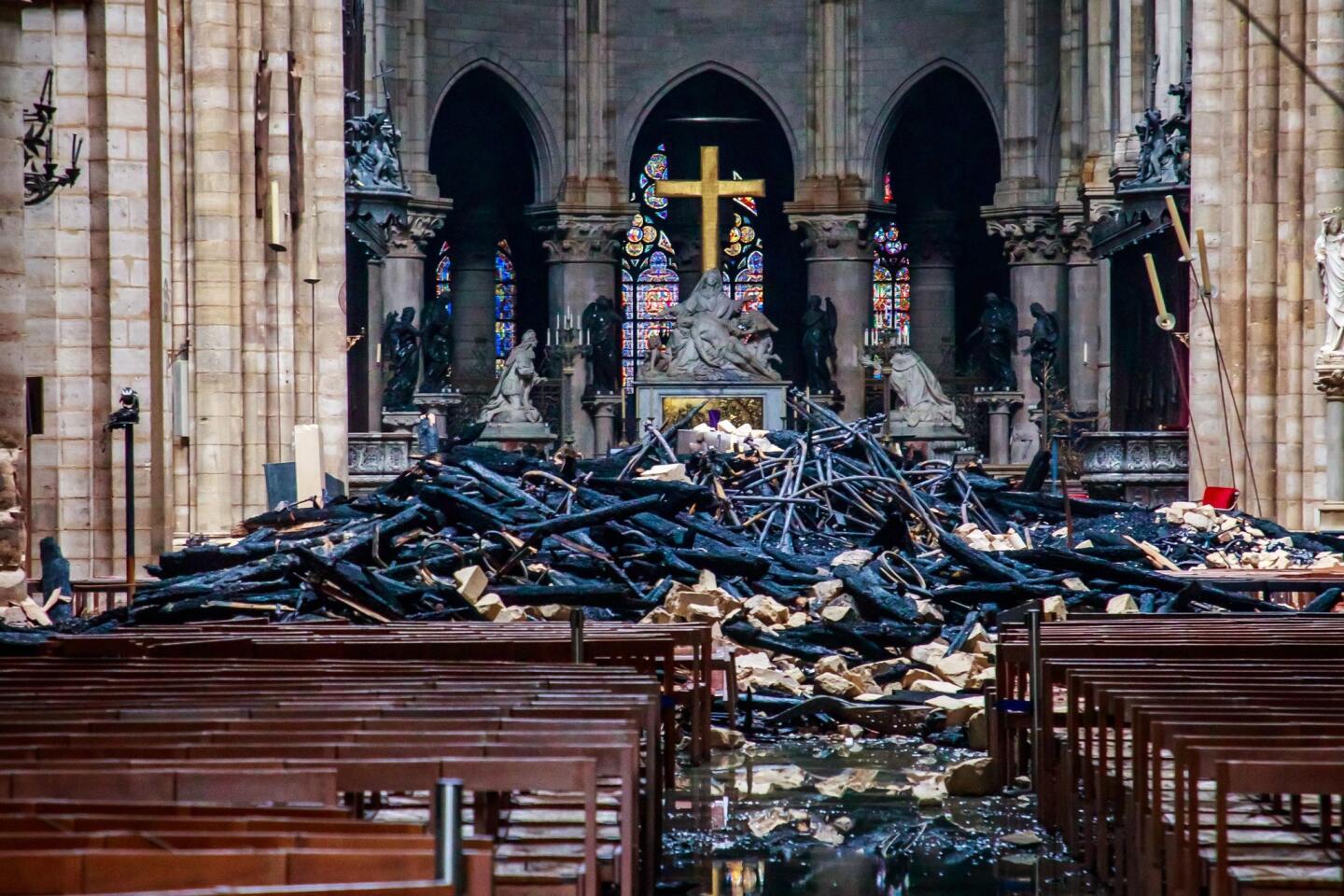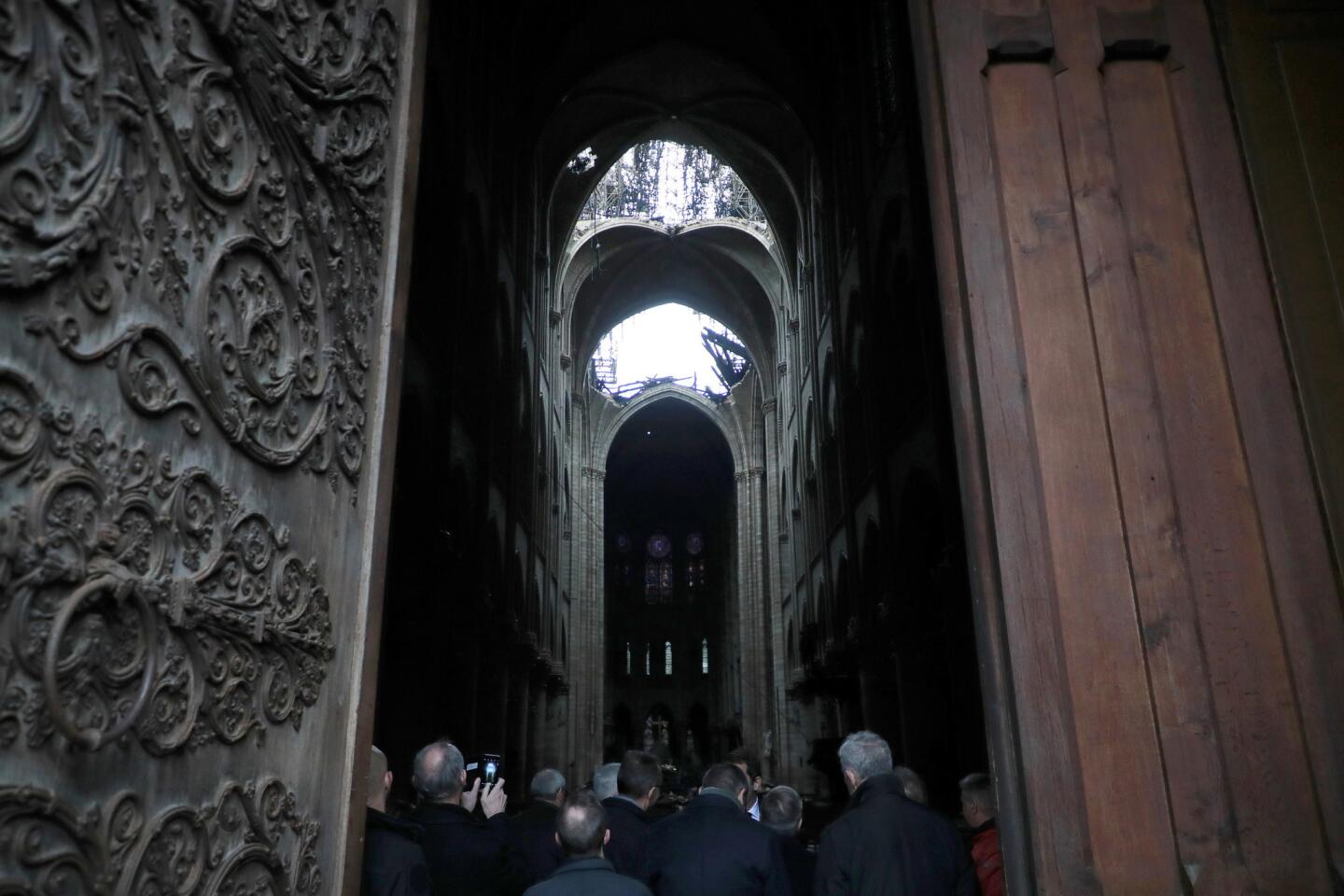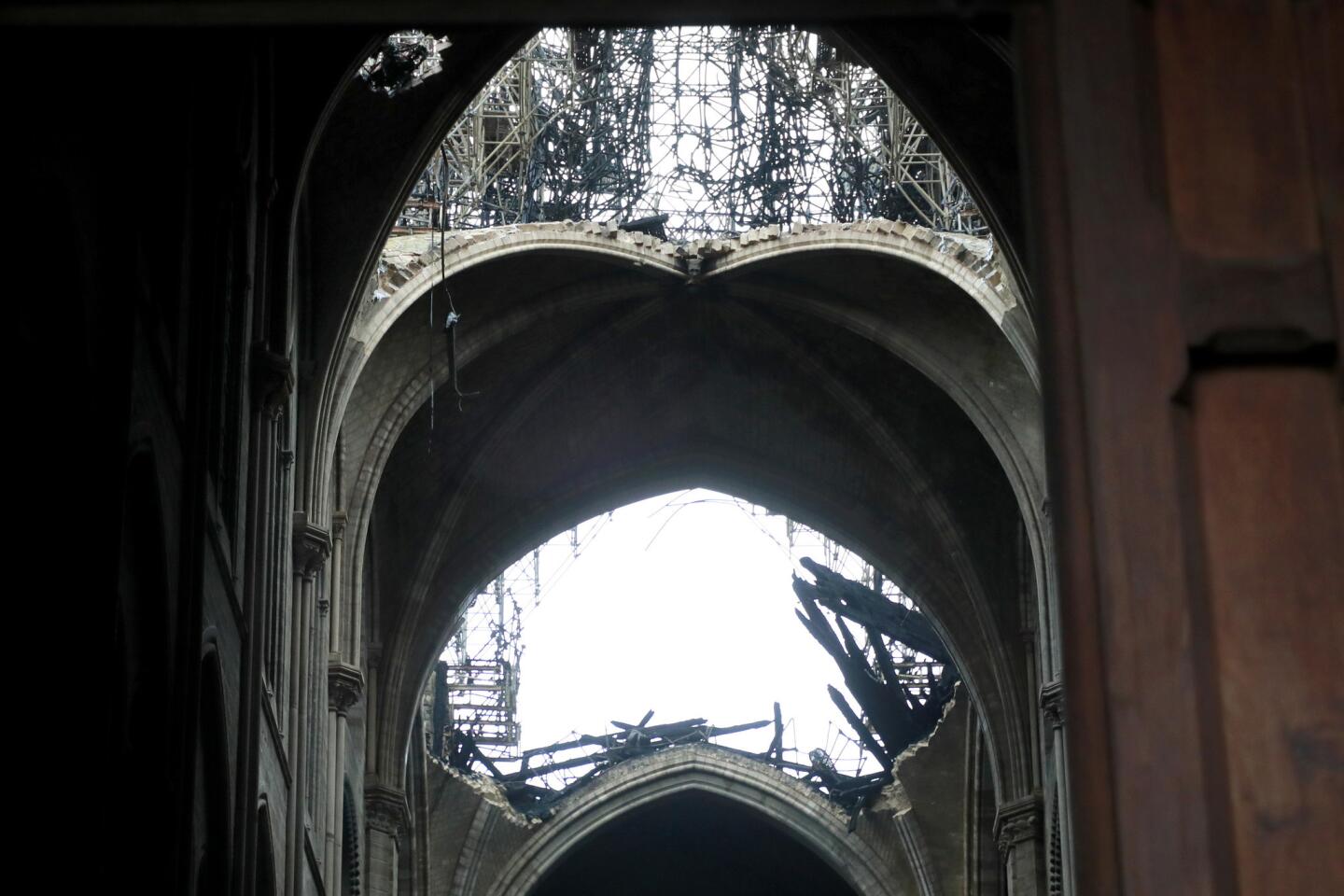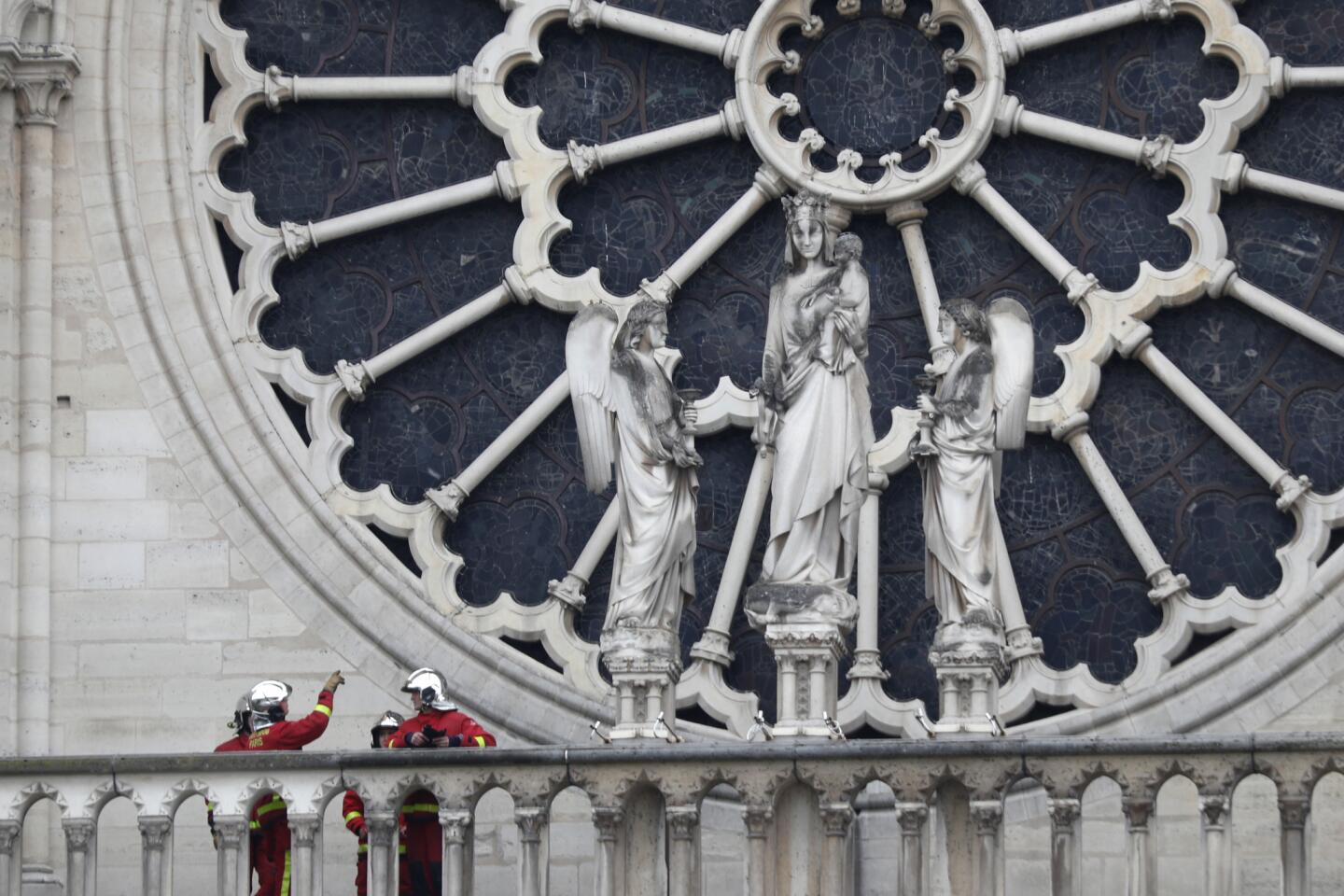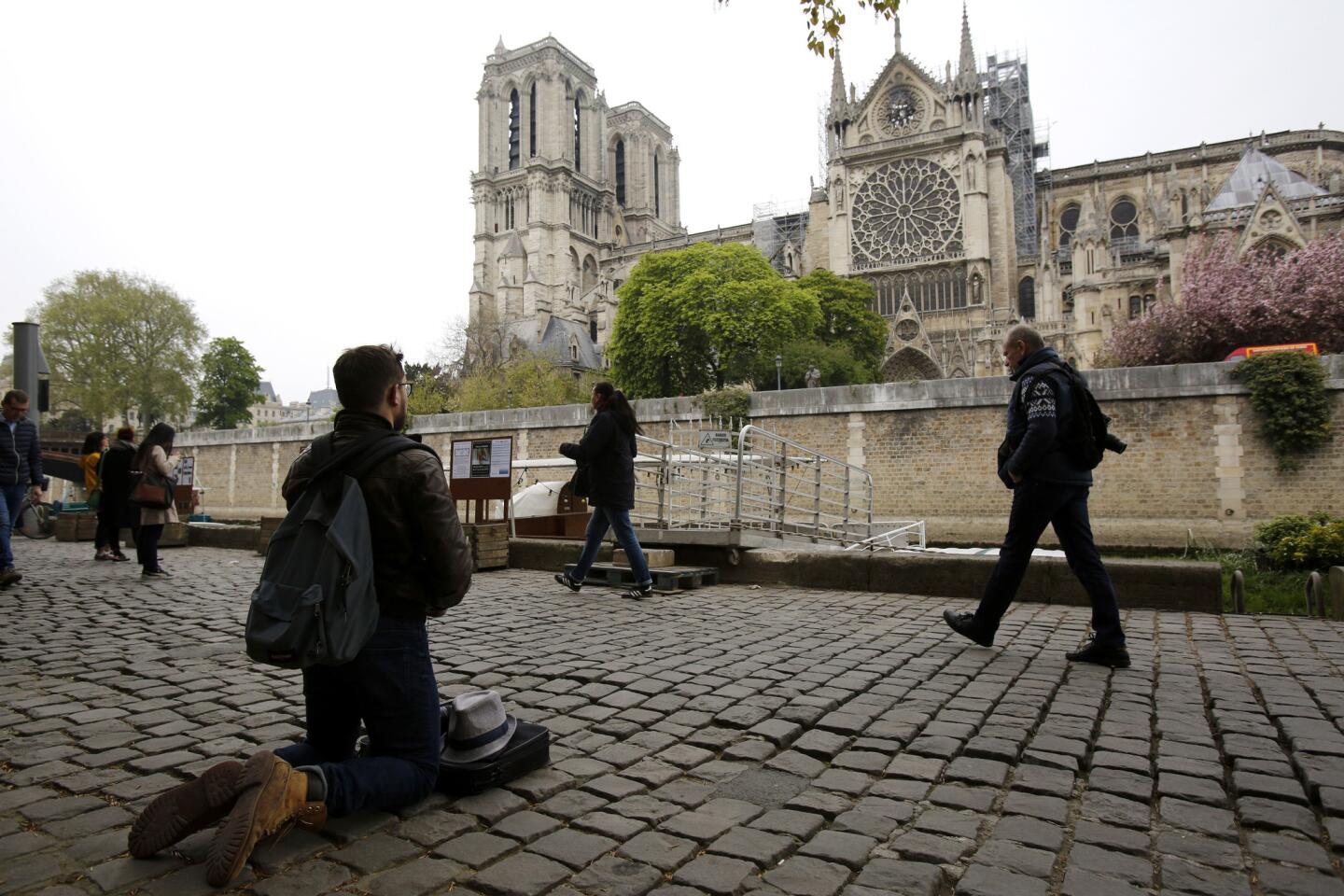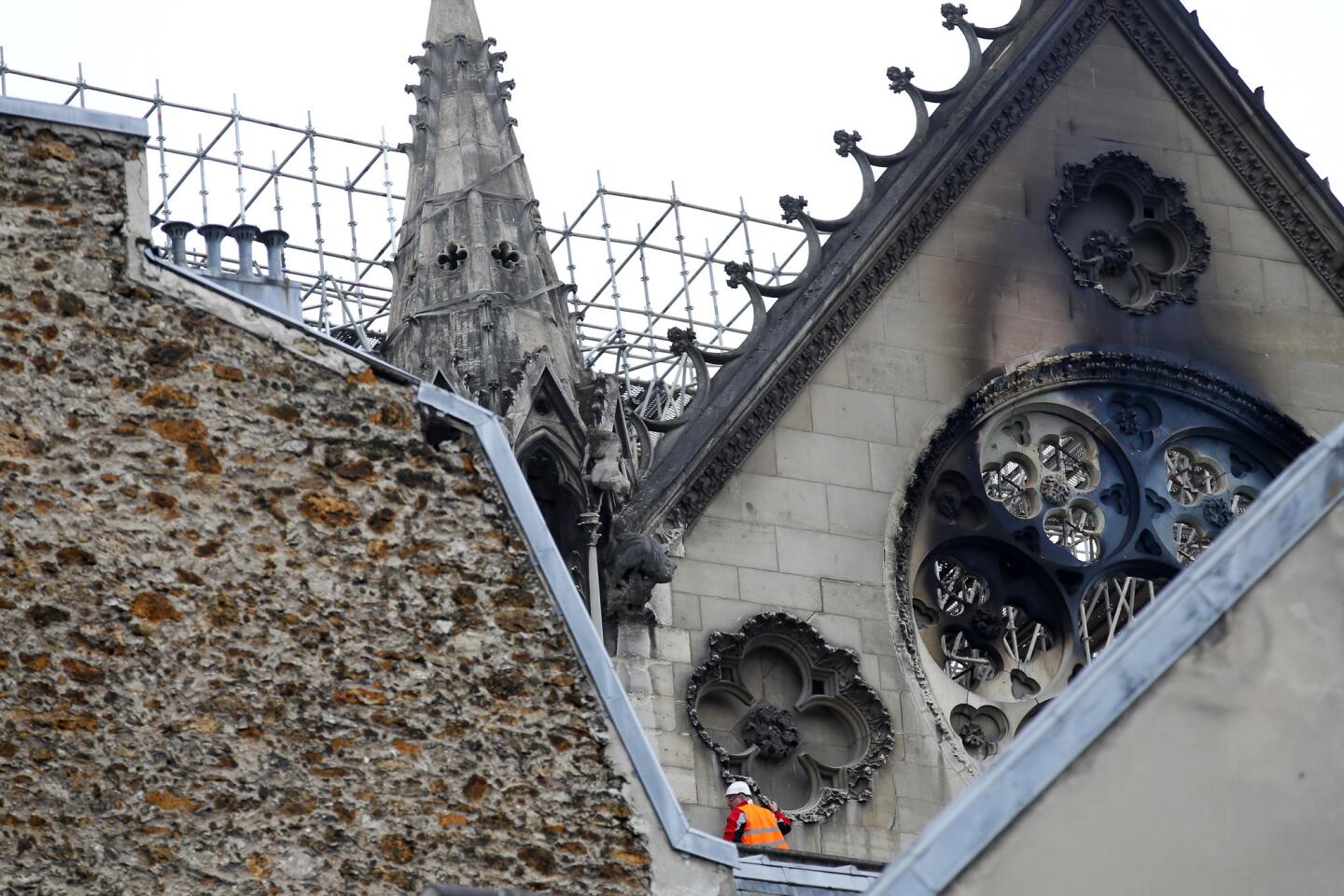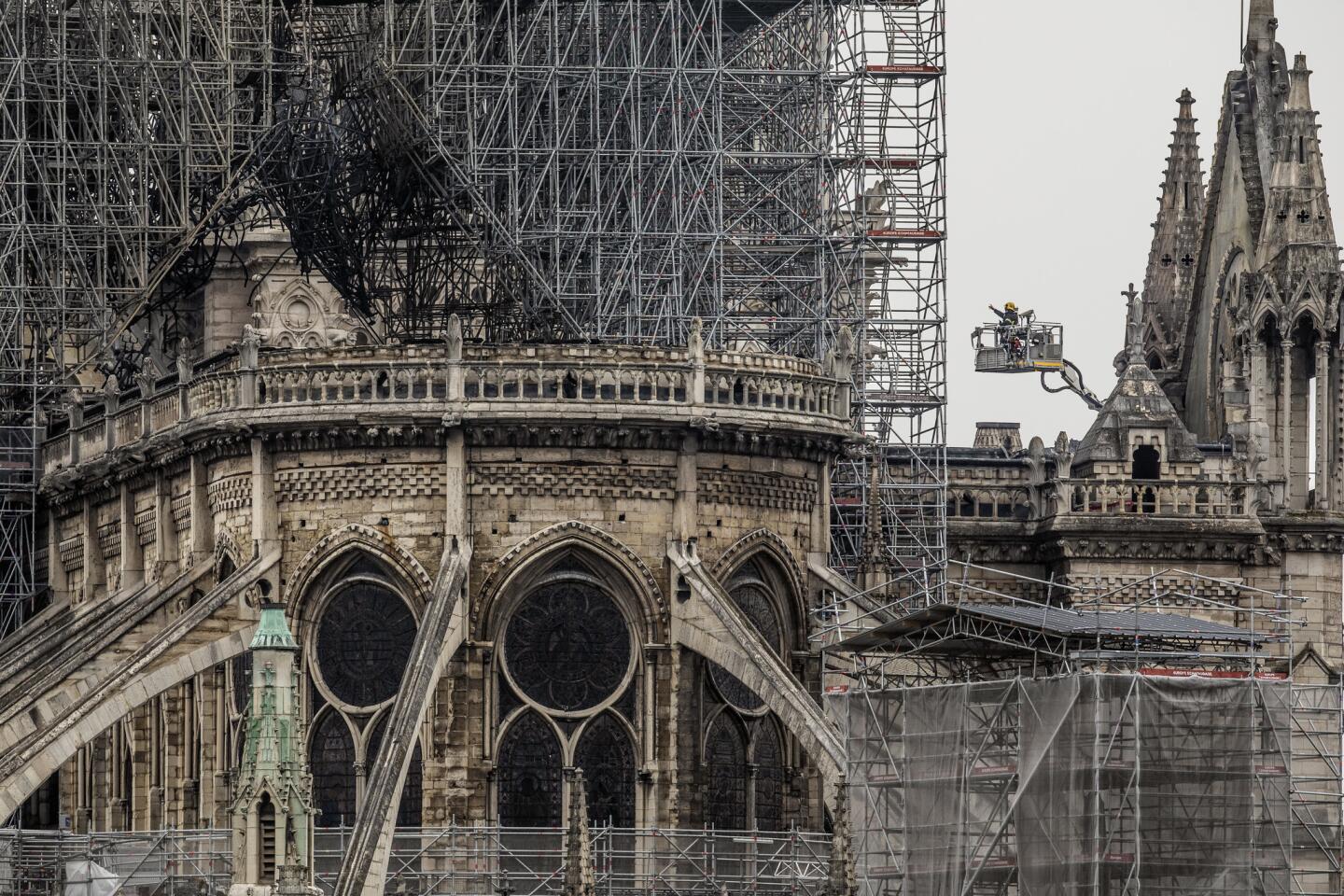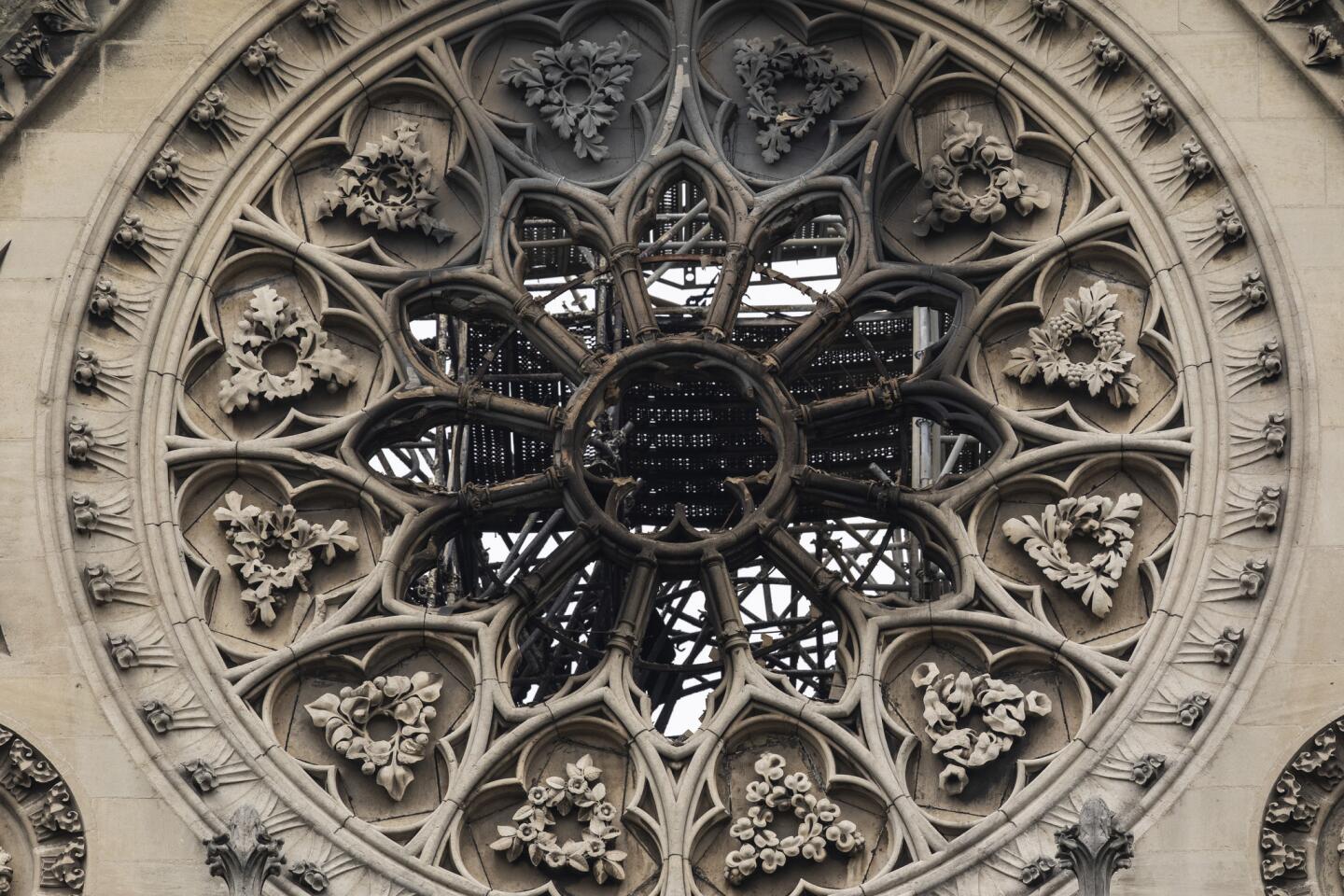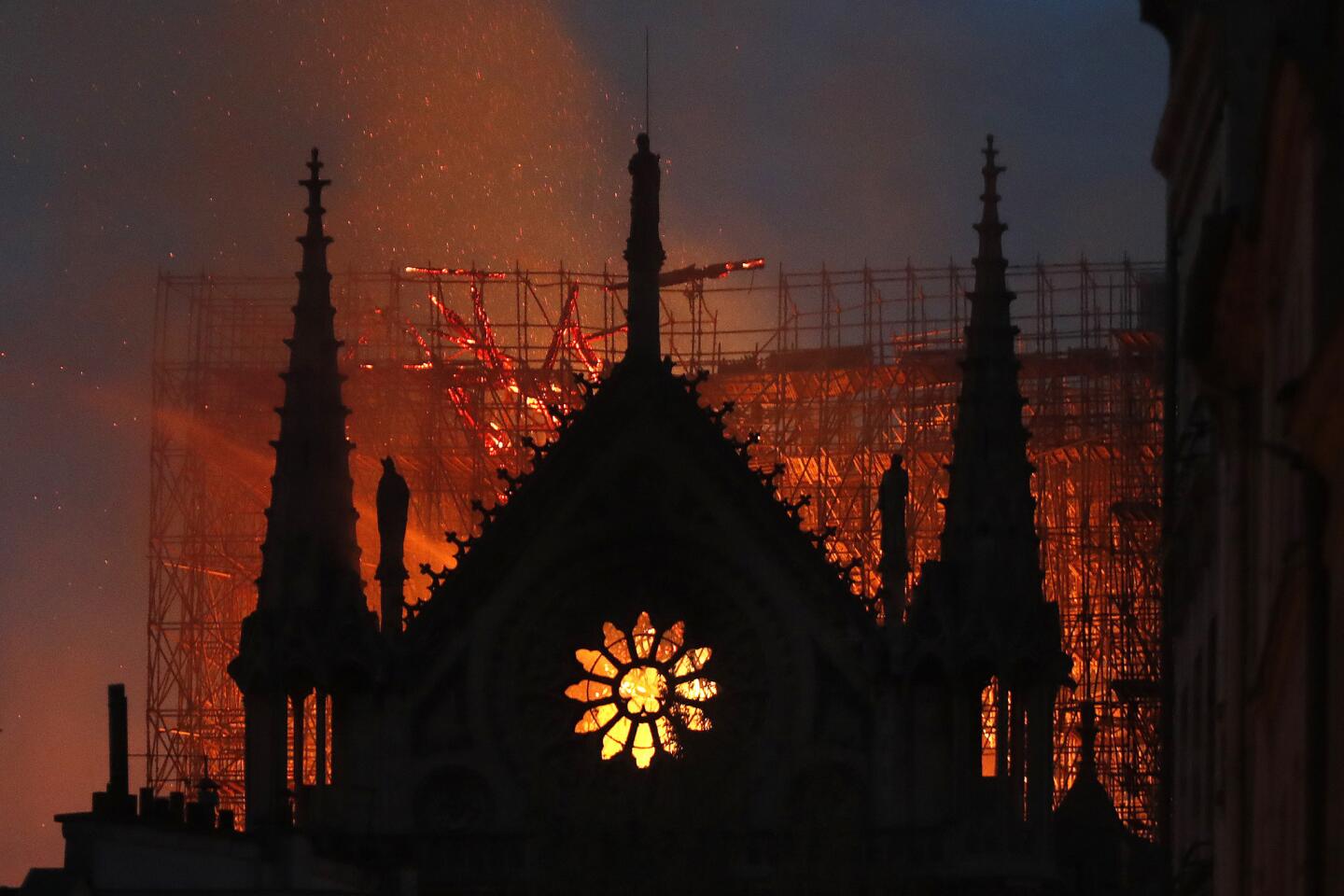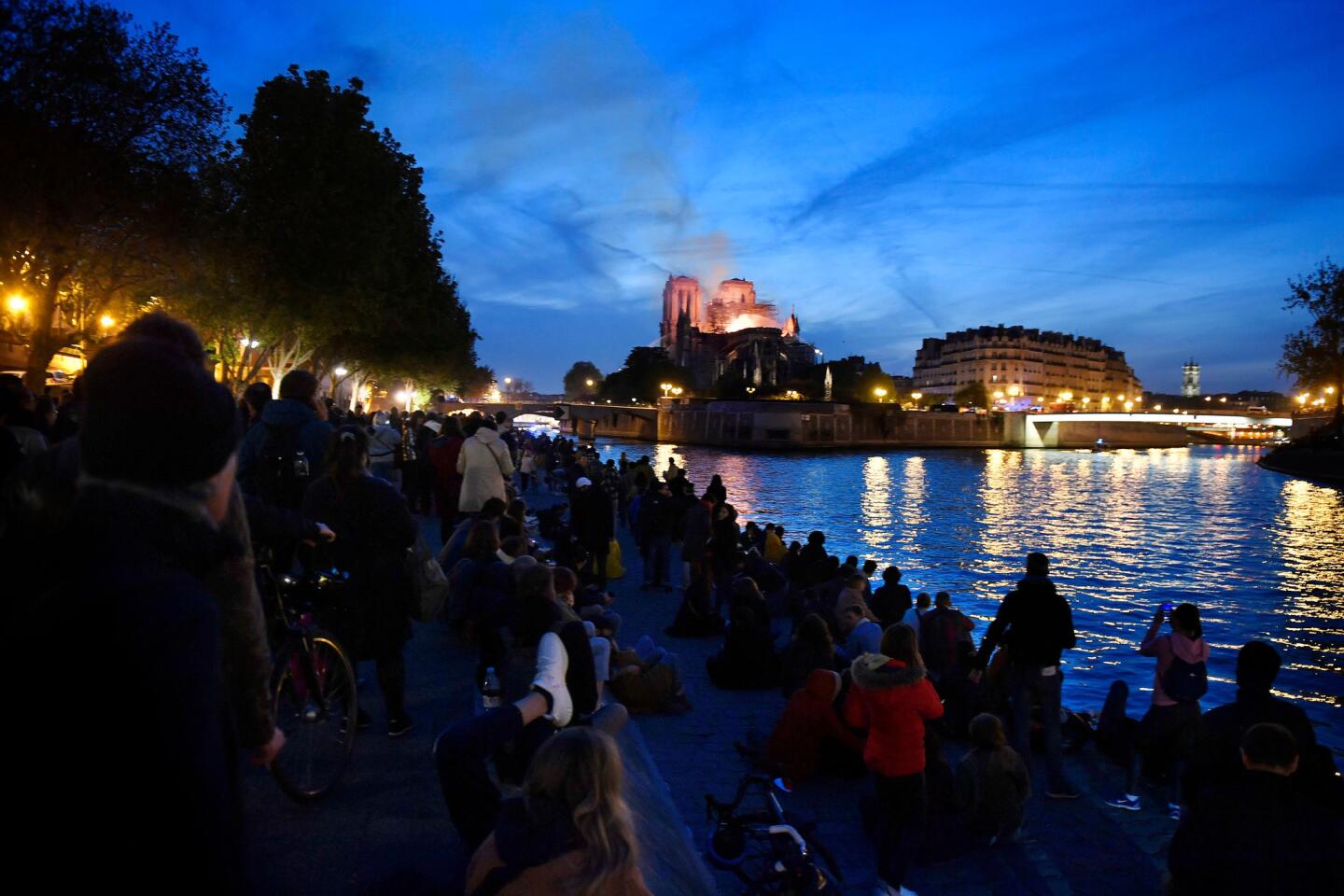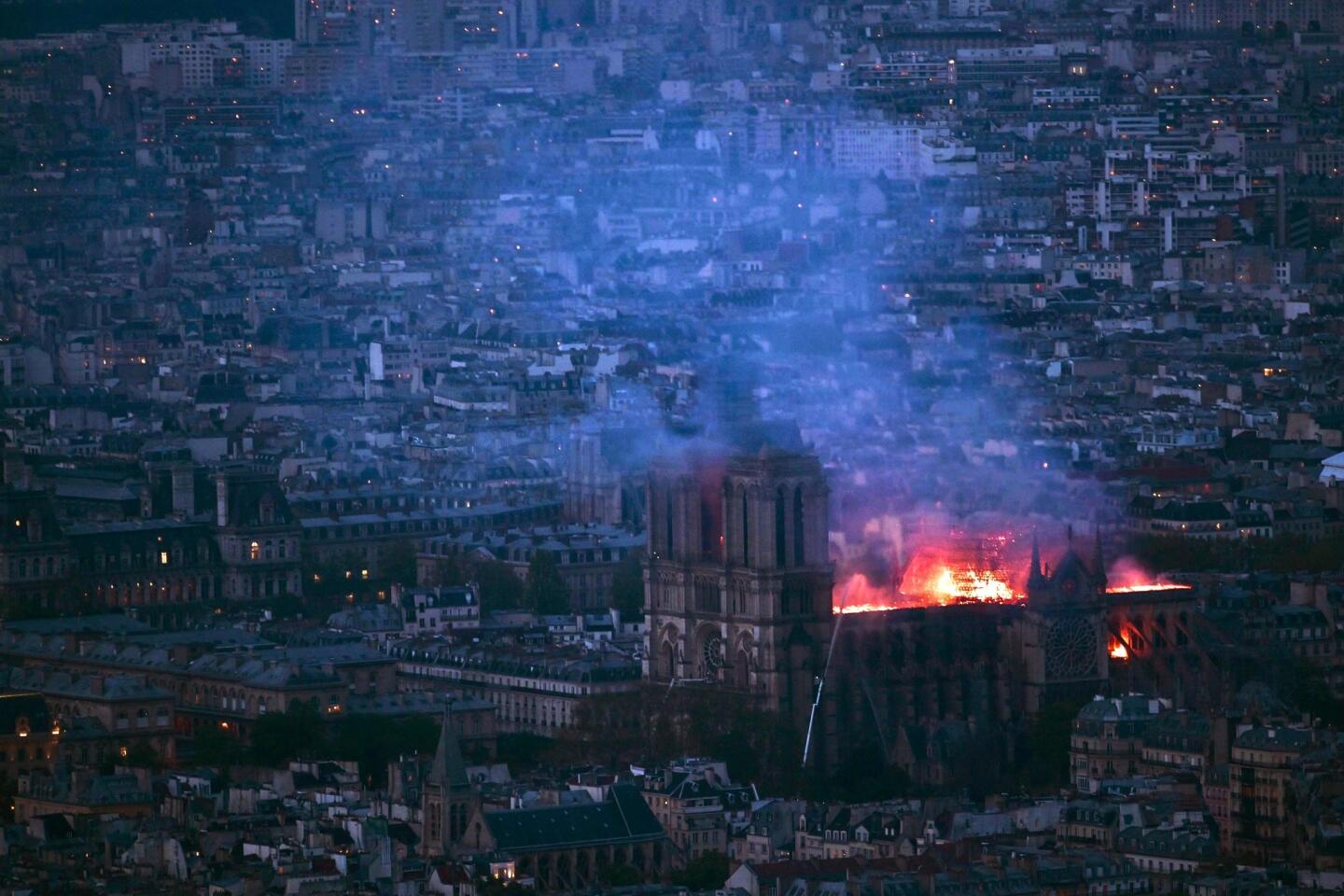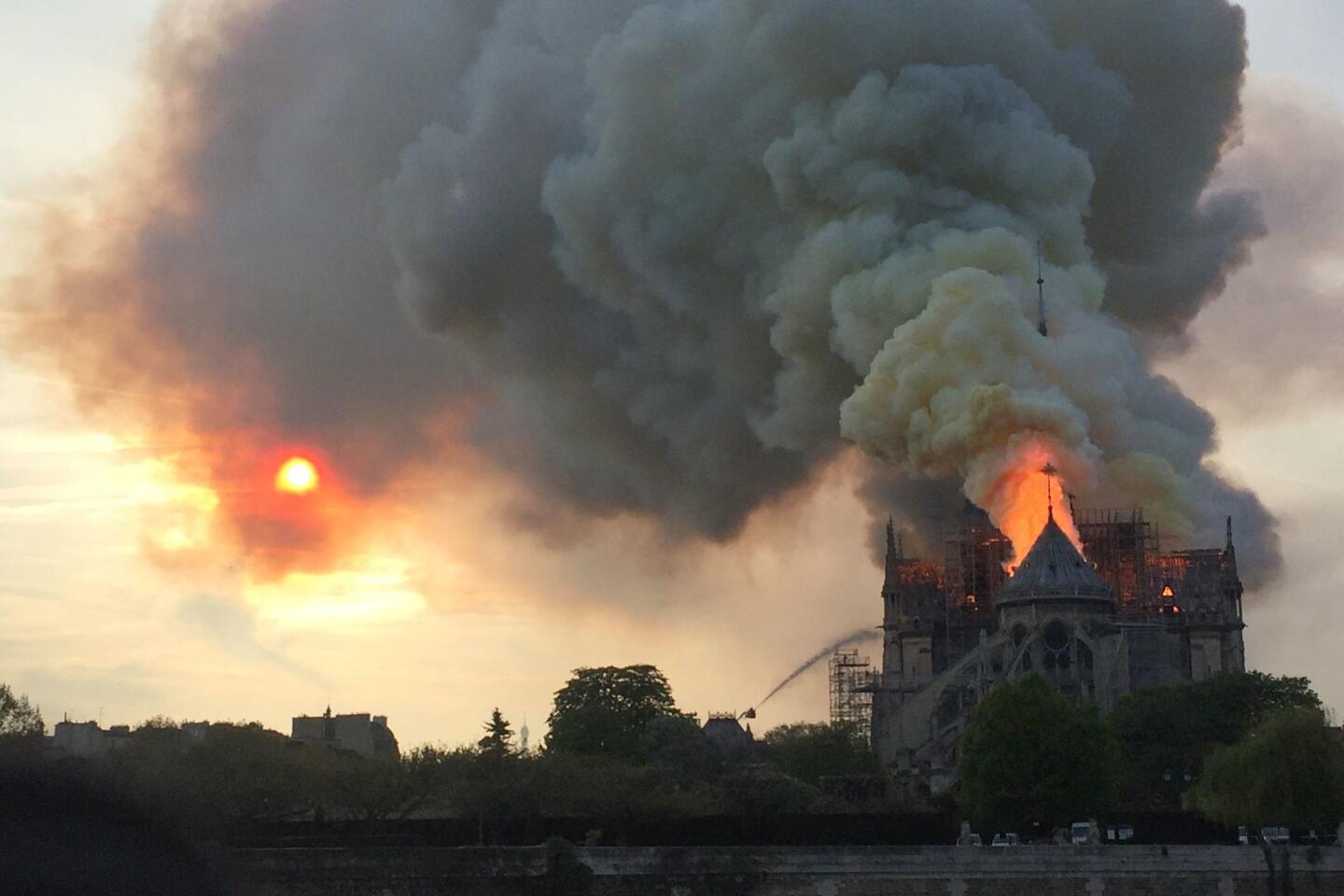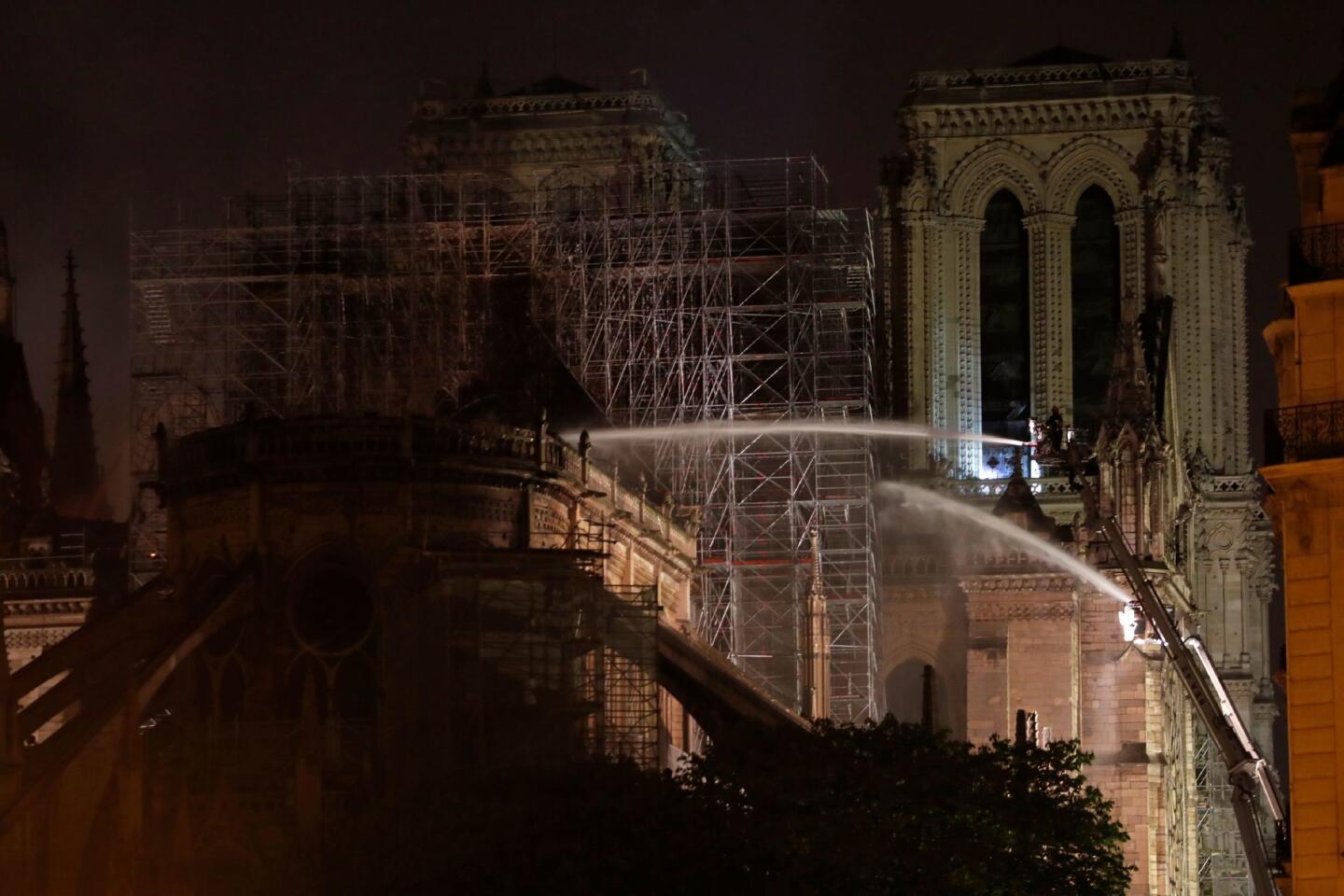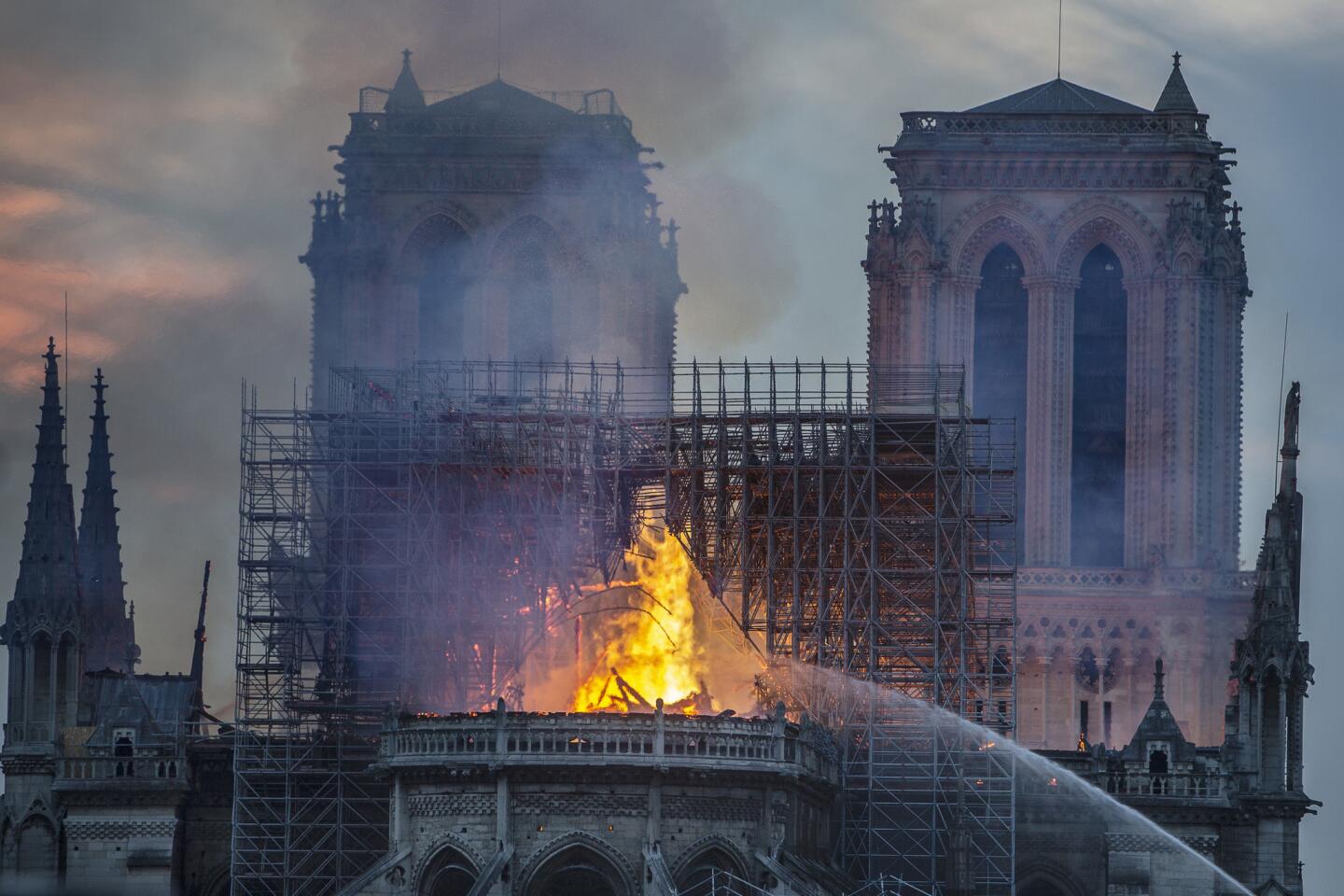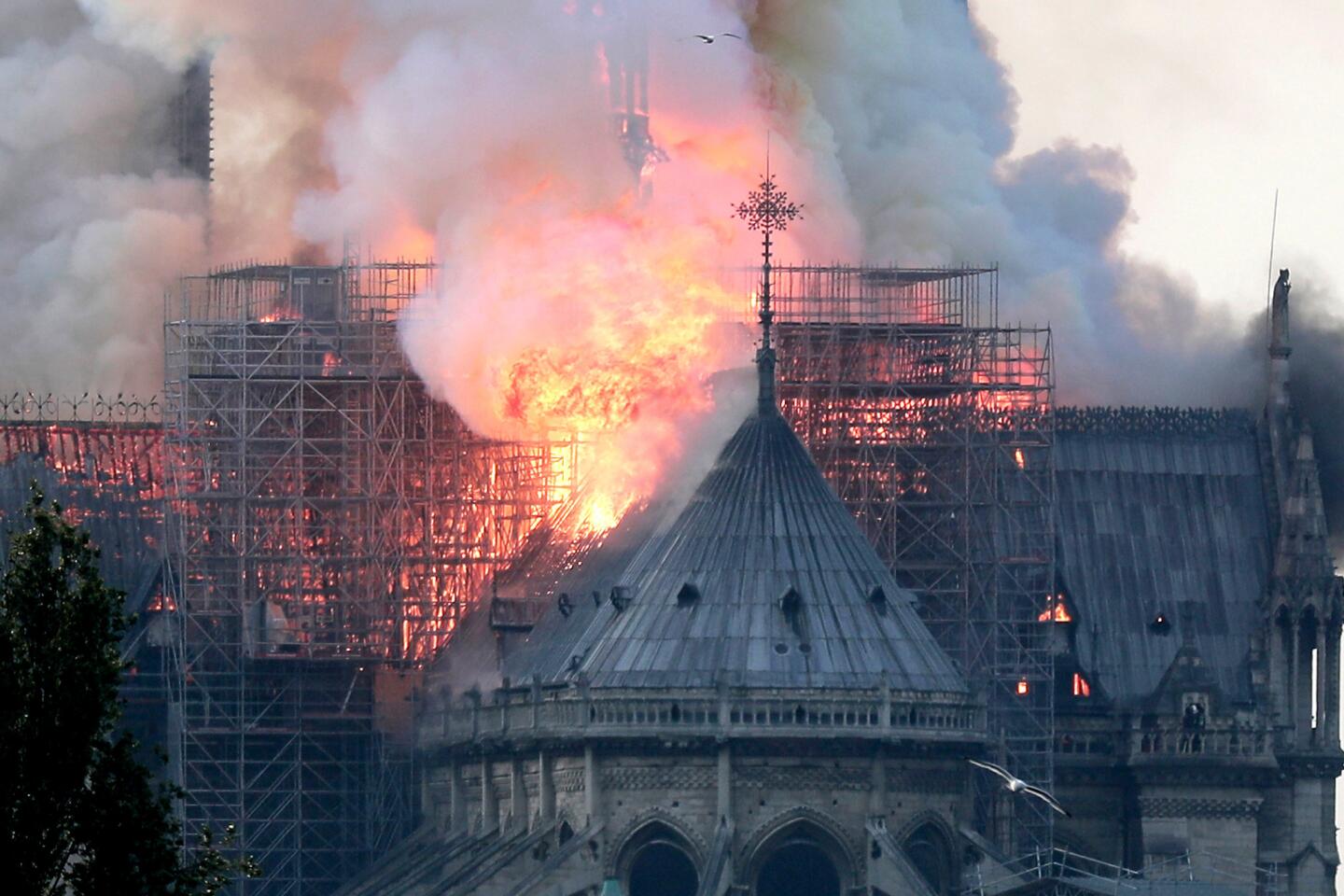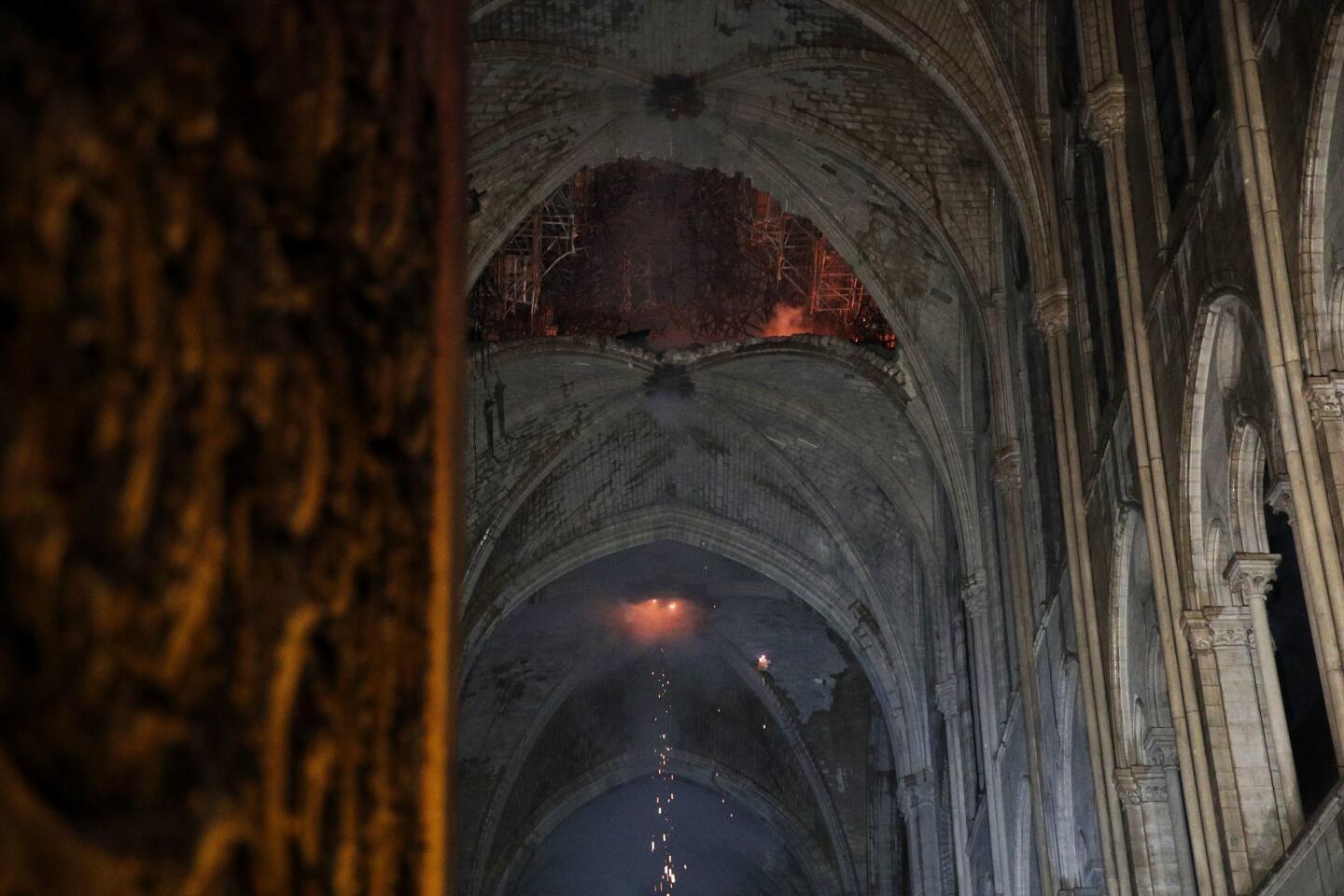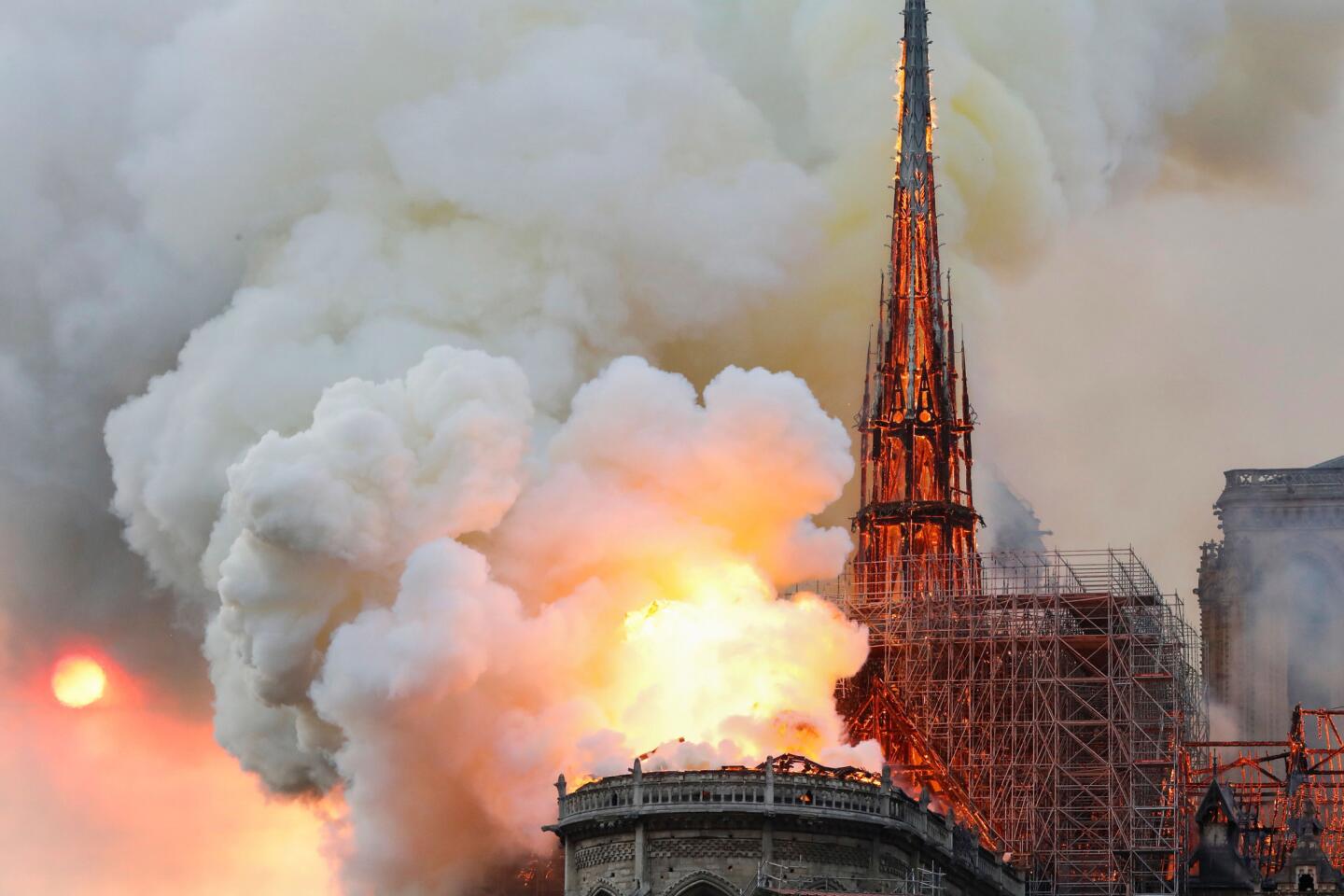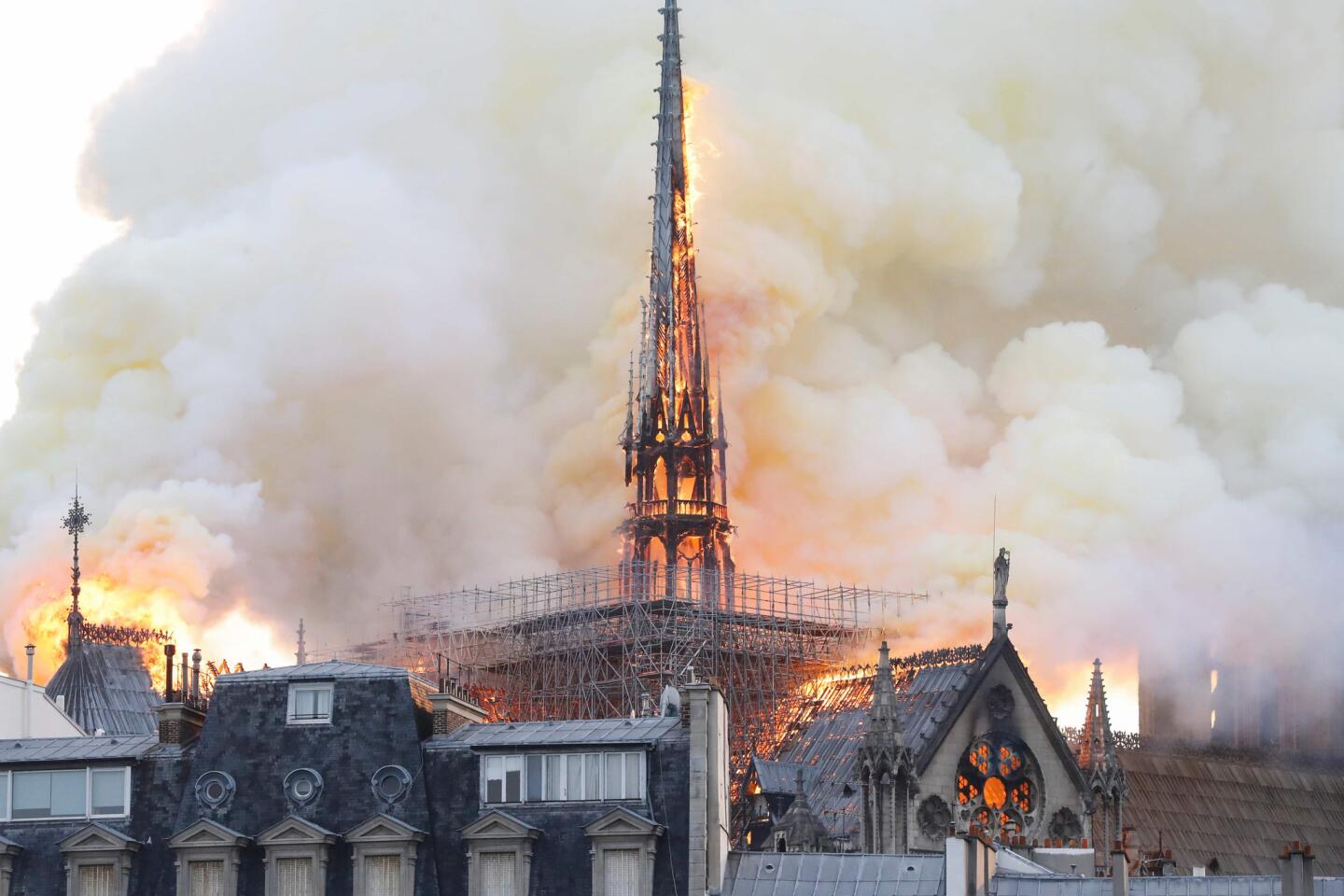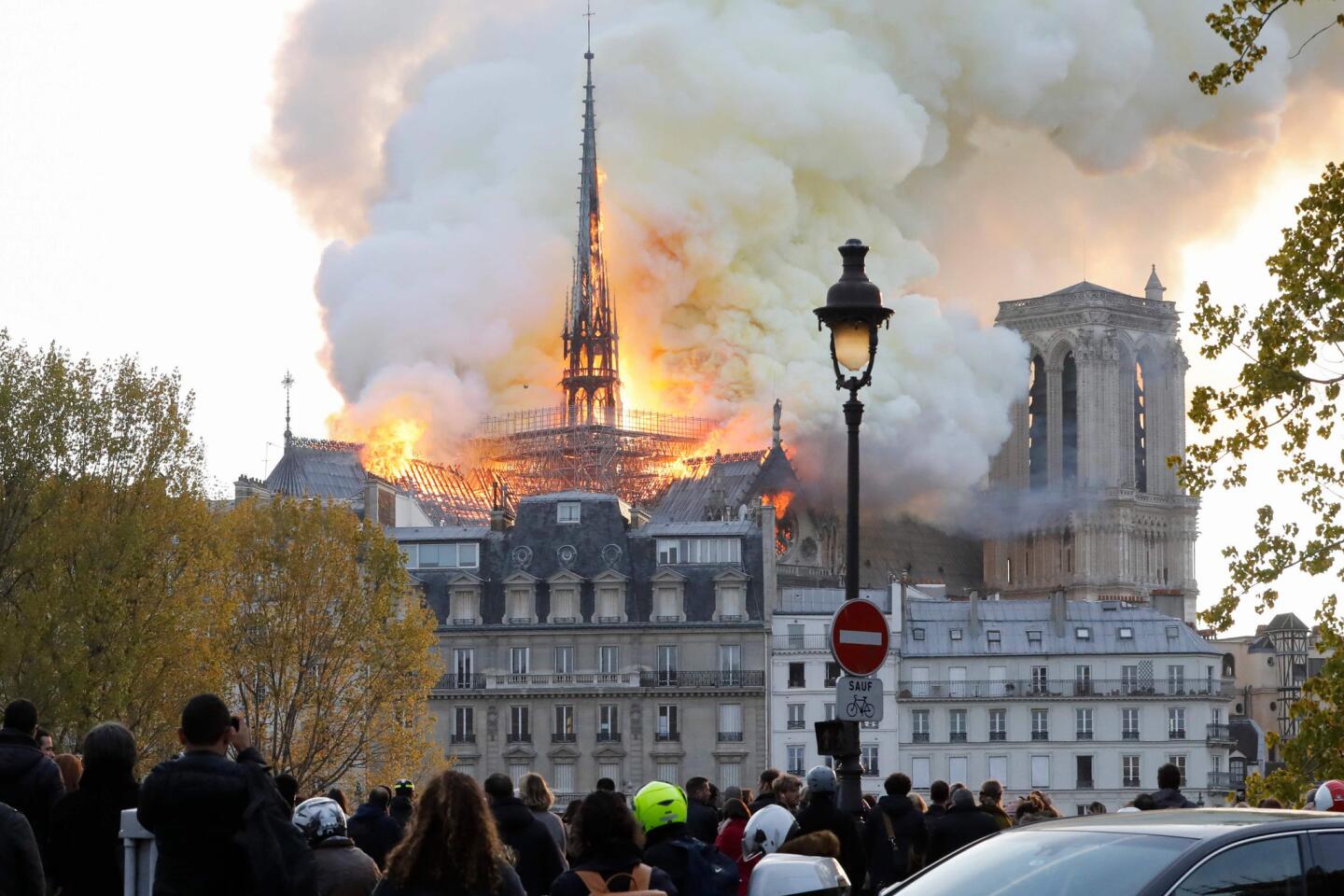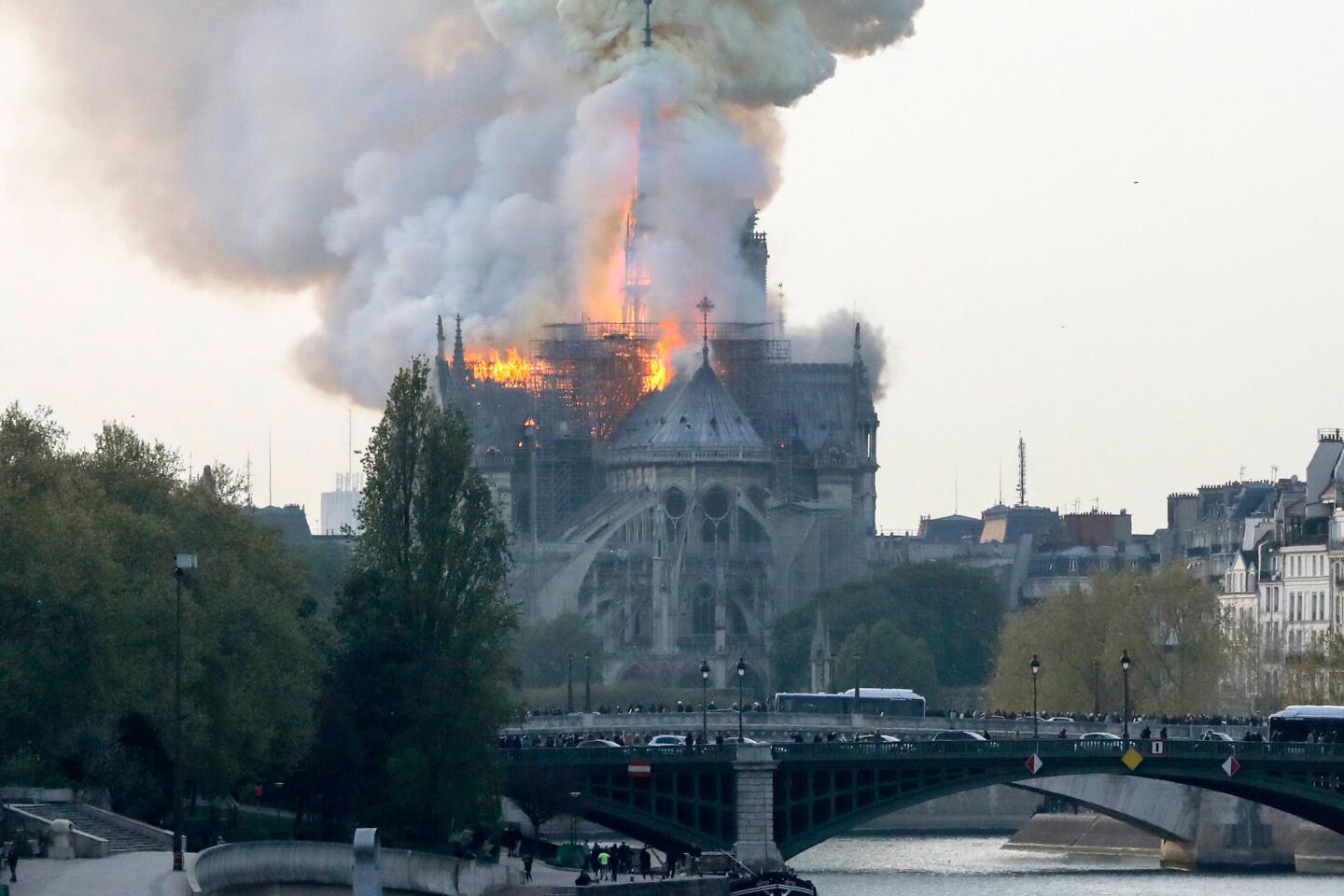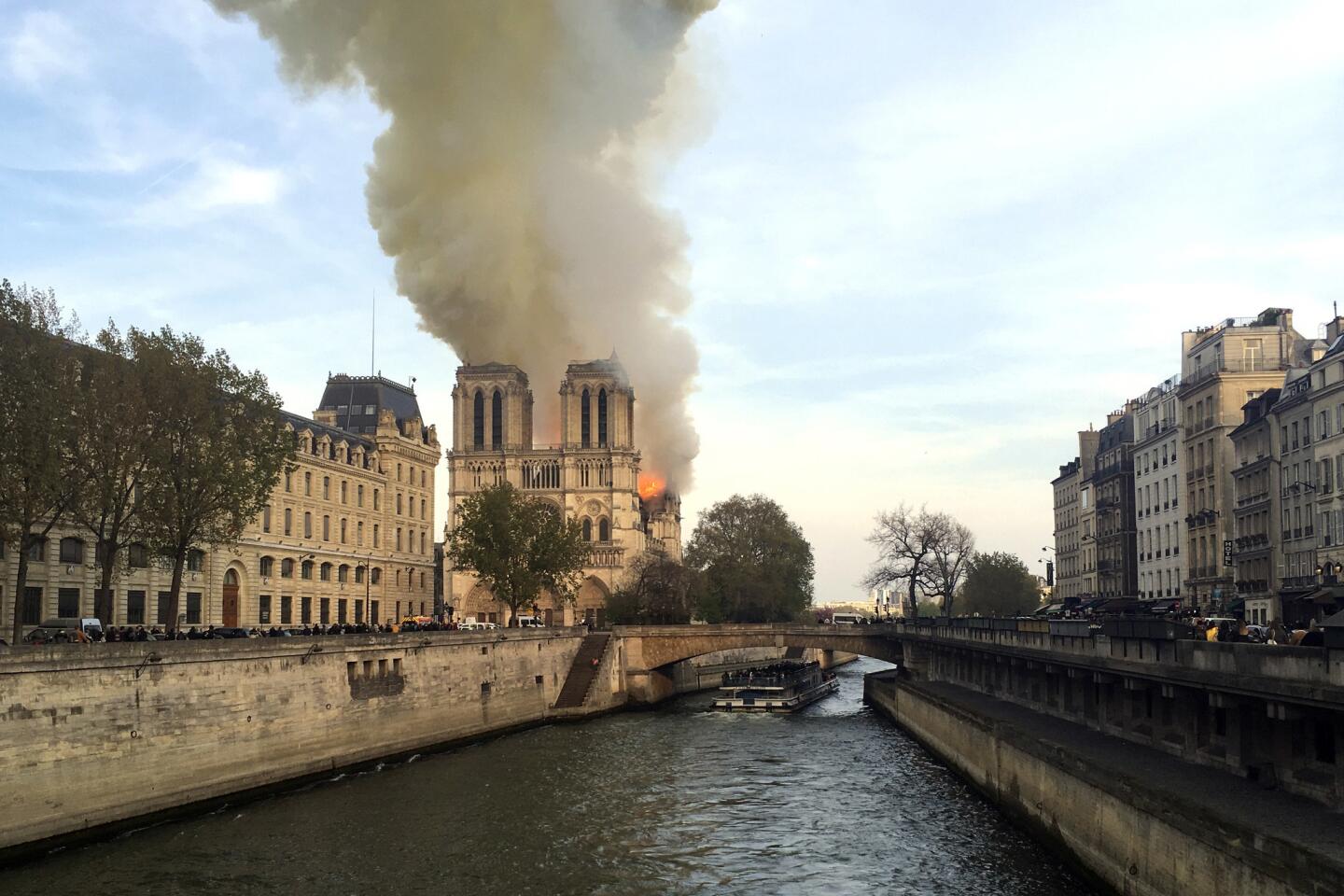Notre Dame Cathedral devastated by fire, but part of the Paris icon is saved
- Share via
Reporting from Paris — In the latticed shadows of the medieval masterpiece that was Notre Dame de Paris, centuries of history unspooled: two calamitous world wars, bubonic plague, revolution, the sprawling, messy intricacies of daily life. Its mighty bells clanged at momentous junctures — when Paris was liberated from the Nazis in 1944, in tribute to the victims of the Sept. 11 terrorist attacks.
On Monday, it was the bells of Paris’ other churches that tolled — in an anguished, prayerful gesture of solidarity and support for the burning cathedral.
Onlookers wept and gasped in horror as more than 400 firefighters fought the ferocious and fast-moving blaze, which broke out about 6:45 p.m., destroying large parts of the 850-year-old Gothic monument.
Firefighters said the roof had been mostly destroyed, and at one point they feared the entire structure could collapse. Flames licked up the tall spire, which eventually buckled and collapsed in on itself, but by midnight, with the fire’s intensity finally fading, officials at the scene said the cathedral structure, including the two towers on the main facade, had been saved.
Among the sea of dismayed faces watching the flames, TV cameras found Patrick Chauvet, the rector of Notre Dame. “Catastrophe,” he murmured.
There were fears for the three famed “rose” stained-glass windows and treasures inside the cathedral, though many had been removed as the building was undergoing renovations. Firefighters rushed to save other works of art from inside the building.
Massive clouds of smoke filled the evening sky and embers from the burning building rained down on neighboring streets.
At the end of a long spring day, the early evening sky was still bright blue when flames began erupting from the grand structure’s roof, but as night fell, the scene resembled a Renaissance painting, with the cathedral’s looming towers suffused with an eerie glow and silhouetted against a roiled and darkening sky.

French media quoted the Paris fire brigade saying the Notre Dame Cathedral fire is “potentially linked” to the renovation work.
A spokesman for the cathedral said the wooden interior had been consumed by fire, as had the wood and lead spire, which was renovated in the 19th century after it collapsed in 1792.
Even assessing the scope of the destruction will take time: Jean-Claude Gallet, commander of the Paris fire brigade, said: “We now have to cool the structure.”
The fire is believed to have started in the ribbed roof area, some of whose heavy timbers dated to the cathedral’s early centuries. The Paris prosecutor’s office opened an investigation into “involuntary destruction by fire,” suggesting officials did not think it was a criminal act.
A visibly emotional French President Emmanuel Macron, speaking to journalists at the scene, pledged the cathedral would be rebuilt.
Praising the courage of firefighters who battled the blaze, Macron said he would launch a national “subscription” to raise funds and would call on specialists around the world to help with reconstruction.
“This cathedral we will rebuild, all together,” he vowed. “We will rebuild Notre Dame because that’s what the French expect; that’s what our history deserves.”
Five things to know about Notre Dame Cathedral »
The immediate area was cordoned off soon after the fire broke out, but from across the Seine, thousands of onlookers clustered on old stone steps and quays, some with arms wrapped around one another and others wiping their eyes.
In one cluster of spectators, a ragged chorus of “Ave Maria” arose.
Moctar Kane, a freelance journalist, watched the billowing smoke and flames — taking pictures and video that he, like many, posted on social media. He said he was struck by the collective air of shocked, nearly silent sorrow, as if seeing a loved one in distress.
“Everyone watched so sadly and so quietly,” said Kane, who was born and raised in Paris.
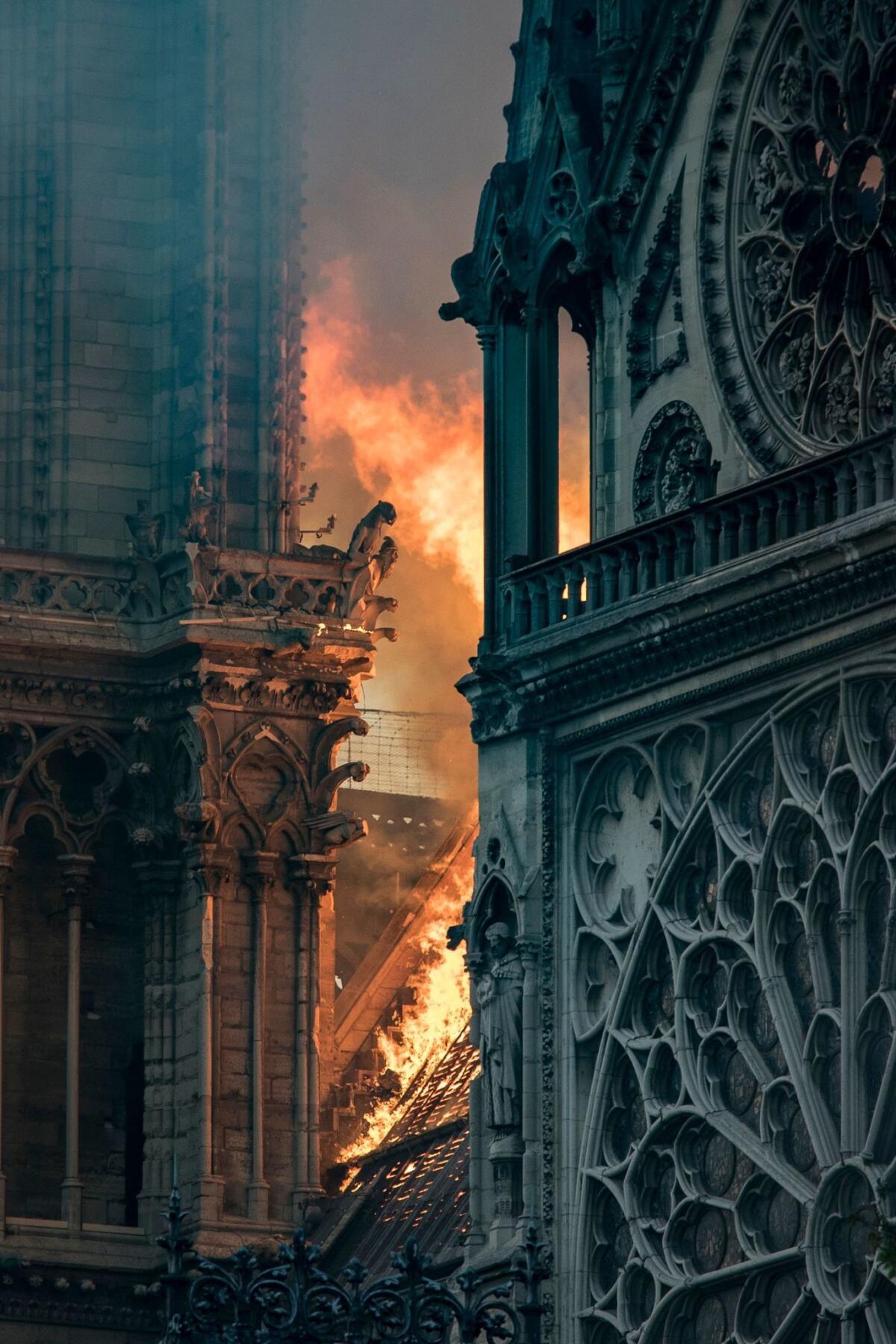
Among the devout, the misery of the spectacle was heightened by the timing: Holy Week, just six days from Easter Sunday.
For more than eight centuries, Notre Dame de Paris has been at the heart of the city’s spiritual, intellectual and cultural life.
It has been the scene of royal weddings as well as Napoleon Bonaparte’s consecration as emperor and the beatification of Joan of Arc. The cathedral was immortalized in Victor Hugo’s novel, called “The Hunchback of Notre Dame” in English, which was later transformed into films, including an animated Disney musical.
Speaking through its deformed bell-ringer protagonist, Quasimodo, the novel was a lyrical tribute to the hulking, then-tattered holy place, badly in need of restoration. The cathedral, Hugo wrote, “was peopled with marble figures, kings, saints, and bishops who at least did not laugh at him, and never looked upon him otherwise than with peace and goodwill. The other statues, those of monsters and demons, did not hate Quasimodo; he looked too much like them for that.”
Trump tweets advice for saving Notre Dame; Paris fire officials say it’s a terrible idea »
Located on the Ile de la Cite in the center of Paris and built on the ruins of two earlier churches, the cathedral draws about 13 million tourists a year, who marvel at its flying buttresses, its luminous stained glass, its grotesque but beloved gargoyles.
From across the Atlantic, President Trump tweeted advice, urging French authorities to bring in aerial tankers. Fire officials said helicopters were employed against the fire, but the national civil security force tweeted: “The dumping of water by aircraft on this kind of building could, actually, cause the complete collapse of the structure.”
“Helicopter or aircraft, the weight of water and the intensity of the dumping at low altitude could weaken the structure of Notre Dame and cause collateral damage to neighboring buildings,” it added.
Miraculously for an inferno of this scale, there were no known deaths. Laurent Nunez, a minister of state in the Interior Ministry, said the cause of the blaze was not known. One firefighter has been “seriously injured,” officials said.
Special correspondent Willsher reported from Paris and Times staff writer King from Washington.
More to Read
Sign up for Essential California
The most important California stories and recommendations in your inbox every morning.
You may occasionally receive promotional content from the Los Angeles Times.
